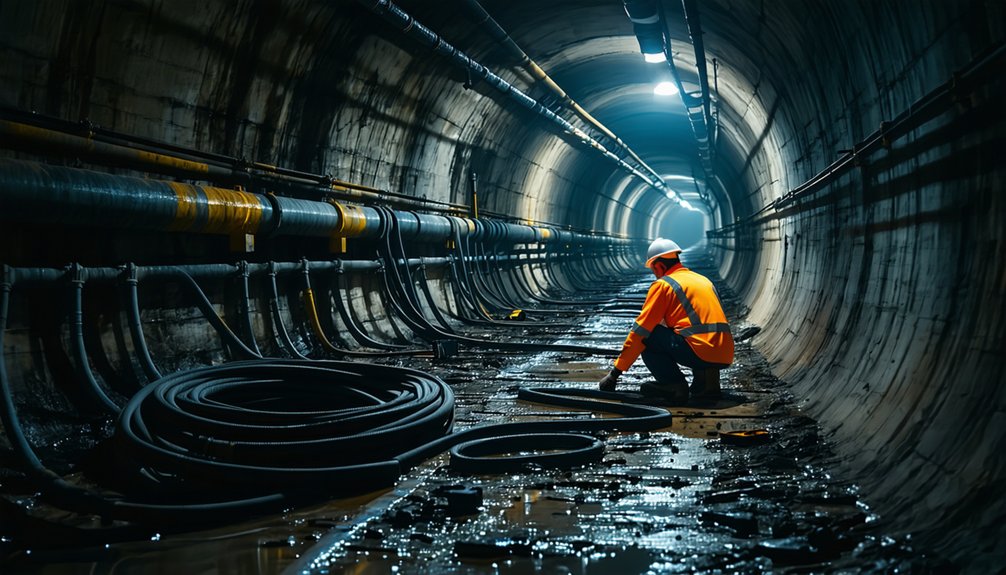Sewer line repair expenses are influenced by several key factors. The extent of damage plays a critical role, with minor issues costing considerably less than extensive repairs. The type of pipe material affects costs; for example, PVC is usually more economical than older materials like cast iron. Accessibility impacts labor costs, while the urgency of repairs can lead to higher charges. Additionally, regular inspections can prevent unforeseen expenses. Further insights into these factors can provide clarity on managing repair costs.
Key Factors Influencing Sewer Line Repair Costs
Repairing sewer lines involves various cost determinants that can greatly impact the overall expense. Key factors influencing repair costs include the extent of the damage, which ranges from minor issues, such as tree root removal costing approximately $300, to extensive damage requiring complete overhauls that may exceed $20,000. The type of pipe material also plays a significant role; modern PVC pipes are generally more cost-effective and durable compared to older materials like cast iron or clay. Additionally, the accessibility of the damage site is vital, as repairs in hard-to-reach areas often necessitate specialized equipment, thereby increasing labor costs. Emergency repairs typically incur higher charges due to the urgency involved, while proactive maintenance and thorough inspections can mitigate unforeseen expenses. Traditional excavation methods may further influence costs, underscoring the importance of understanding these determinants for effective financial planning in sewer line maintenance.
The Impact of Pipe Material and Condition
The choice of pipe material and its condition greatly dictate the financial implications associated with sewer line repairs. PVC pipes are generally more durable and less expensive to repair than cast iron pipes, which are prone to corrosion and may require substantial section replacements. Older materials, such as clay or cast iron, often necessitate complete replacements due to compatibility issues with modern repair techniques, greatly escalating repair costs. Additionally, pipes constructed from PCCP can incur internal gas damage, leading to further costly repairs. The condition of the pipes plays a vital role; minor issues in well-maintained PVC lines may only require simple patching, while extensive damage in cast iron pipes could lead to costs exceeding $20,000 for full replacements. The compatibility of new materials, particularly PVC, with existing infrastructure can facilitate effective management of future repair costs, enhancing the overall lifespan of the sewer system.
Understanding Repair Methods and Their Costs
When evaluating sewer line repair methods, it is essential to contemplate both the techniques available and their associated costs, as these factors greatly influence the overall financial outcome of the repair process. Traditional excavation is often invasive, potentially leading to significant restoration costs. In contrast, trenchless sewer line methods, such as pipe lining and pipe bursting, typically range from $80 to $250 per foot, minimizing landscape disruption. For minor repairs, costs may range from $1,100 to $4,000, while extensive damage can dramatically escalate expenses. Tree root removal, a common issue, varies from $300 to $1,100 based on severity. Labor costs also play a significant role, with traditional methods requiring more time and specialized equipment, resulting in hourly rates of $50 to $150 or more. Video inspection, costing between $100 and $500, provides essential diagnostics for estimating repair costs and selecting appropriate methods for addressing sewer line issues.
Frequently Asked Questions
Why Is Sewer Line Replacement so Expensive?
Sewer line replacement incurs significant costs due to various factors. Sewer repair costs are influenced by replacement materials, labor expenses, and inspection fees. Pipe accessibility complicates repairs, especially if structural damage is involved. Compliance with local regulations adds further expenses. Emergency repairs often command premium rates. Additionally, technology upgrades for long-term solutions can elevate initial investments, necessitating a detailed analysis to justify these costs against expected benefits and durability.
Are Local Governments Responsible for Paying for Sewer Line Repairs?
Local governments are primarily responsible for maintaining public sewer infrastructure, yet homeowners often shoulder repair costs for lines extending to their property. This division of sewer maintenance funding raises questions about taxpayer implications and municipal budget allocations. While community sewer programs may offer assistance, the impact of municipal regulations on sewage system ownership complicates funding sources. Public health considerations underscore the need for clear guidelines on repair responsibilities and available support within local jurisdictions.
Is a Sewer Line Covered by Homeowners Insurance?
Homeowners insurance often lacks sewer coverage, with many policies imposing exclusions on repair claims related to damage from tree roots or neglect. Homeowner responsibilities include understanding policy limits and ensuring adequate coverage for potential emergencies. Maintenance tips may mitigate risks, yet the need for a separate sewer line warranty is common. Damage assessments can reveal gaps in insurance, prompting homeowners to evaluate various contractor options for unexpected repairs and associated costs.
What Is the Life Expectancy of a Sewer Line?
The life expectancy of a sewer line resembles the resilience of a well-tended garden, flourishing under ideal conditions. Factors influencing sewer line lifespan include pipe material durability, environmental factors such as soil conditions, and maintenance practices. Installation techniques and age impacts play vital roles, while local regulations can dictate standards. Usage patterns and potential root intrusion further affect longevity, making proactive care essential for extending the life of sewer infrastructure.



